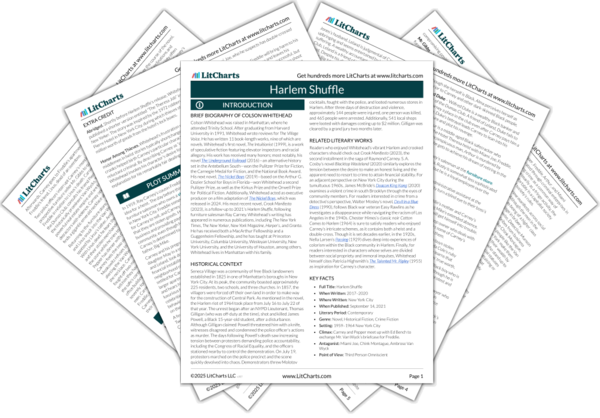The Harlem riots represent the different ways crime is defined and justified in an unequal society. The tension at the center of the riots revolves around such divergent perceptions: on the one hand, the police officer who kills James Powell believes his actions can be justified as self-defense, while the protesters deem those same actions as unlawful homicide. In the same way, the protesters believe that rioting and looting stores is a reasonable response to the injustice of Powell’s death, while the police who arrest them obviously disagree. It is important to note that the response of the novel’s Black characters is in no way monolithic. Carney, as a Black small business owner, feels conflicted about the riots, understanding the righteous anger of the protesters but worried about his own livelihood. Alma and Leland condemn the rioters and side with the police. Pepper expresses skepticism that the protests will have any lasting effect, and yet he, like Carney, carries a protest flyer on his person as a kind of “talisman or a crooked hymn.” Although the riots occur in the background of Carney’s interpersonal conflicts, then, the novel utilizes this historical event to portray systemic racism as a crime in and of itself, comparable to and with far greater impact than Carney’s own crooked behavior.
Harlem Riots Quotes in Harlem Shuffle
“You’re against the protests now?” Elizabeth said. “After all those benefits for the Freedom Riders?”
“It’s not the students I mind,” Leland said, “so much as the shiftless element that attached themselves. […] They looted everything one day, picked it clean like vultures, and torched it the next. Why would you do that to your own neighborhood store?”
“Why’d that policeman kill a fifteen-year-old boy in cold blood?” Elizabeth said.
“They said he had a knife,” Alma said.
“They said they find a knife the next day and you believe him.”
“Cops,” Carney said.
Small men with big plans, Carney said to himself. If this room was the seat of black power and influence in New York City, where was its white counterpart? The joint downtown where the same wheeling and dealing happened, but on a bigger stage. With bigger stakes. You don’t get answers to questions like that unless you are on the inside. And you never tell.
Later, Pepper explained it was the principle of the thing: Let white people think they can fuck all over you and they'll keep doing it.
That was two months after the night on Park Avenue. […] Carney said, “You said with the riots, what was the point? Everything keeps on the way it is, so all the protests were for nothing.”
Pepper said, “I am right in that. Grand jury had nothing to say about that cop, did it? He’s still on the job, right? But as it pertains to me shooting those dudes…maybe you start small and work your way up.”
It was unreal to have your city turned inside and out. He felt unreal those days of the riots when his streets were made strange by violence. Despite what America saw on the news, only a fraction of the community had picked up bricks and bats and kerosene. The devastation had been nothing compared to what lay before him now, but if you bottled the rage and hope and fury of all the people in Harlem and made it into a bomb, the results would look something like this.












